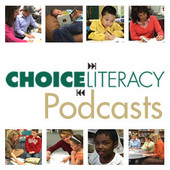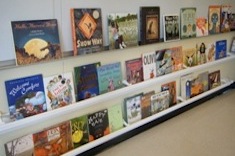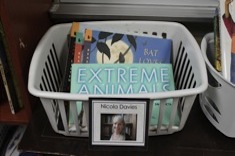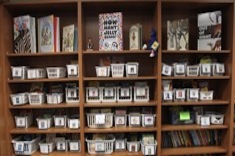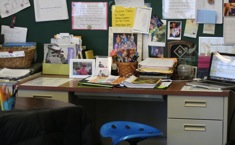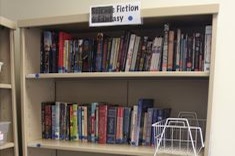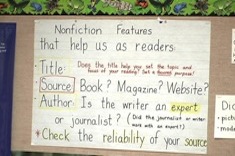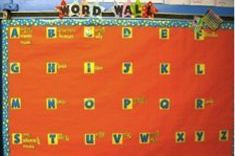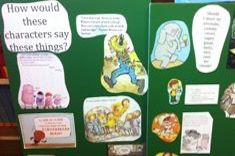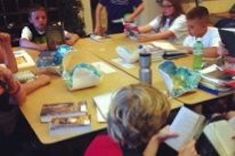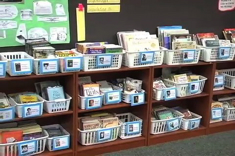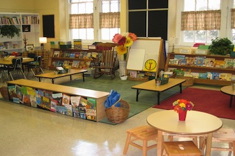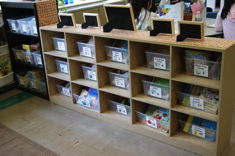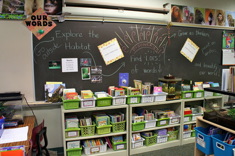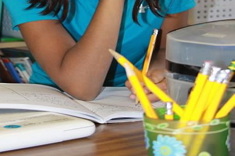Classroom Design
There's been a remarkable amount of brain research demonstrating how crucial environments are for learning. Cozy, well-lit and well-organized spaces are essential for literacy learners of any age. The constraints teachers face in designing and organizing their classrooms are enormous -- from irritated fire marshals to fear of lice infestations, with limited budgets always at the forefront. You'll be inspired by these beautiful classrooms, created by teachers who manage to design spaces any reader or writer would love.
Latest Content
The Information Board: Celebrating Nonfiction Every Day
Andrea Smith builds interest in nonfiction in her fourth-grade classroom community through her constantly changing Information Board.
Habits That Maximize Time
Stella Villalba writes about the importance early in the year of building habits with students that maximize time for English language learners.
Reader Response Anchor Charts
Christopher Carlson describes why and how he made reader response anchor charts more rigorous and thoughtful in his fifth-grade classroom.
Middle School Design: Cozy Reading Spaces
Katie Doherty has design tips for creating cozy reading spaces in middle school classrooms where there is no space or budget for a whole-class rug area.
Smarter Charts (PODCAST)
In this podcast, Franki Sibberson chats with Kristi Mraz and Marjorie Martinelli (the authors of Smarter Charts) about ways teachers can keep anchor charts in their classrooms fresh and useful.
Rethinking Nonfiction Topic-Based Text Sets
Franki Sibberson concludes her series on redesigning nonfiction sections of classroom libraries in the age of the Common Core.
Middle School Design: Reading Gutters
Katie Doherty explains how reading gutters, an inexpensive design feature, dress up her middle school classroom and build community at the same time.
Rethinking Nonfiction Series Books
Franki Sibberson explains how she features nonfiction series books in her classroom library.
Rethinking Nonfiction Author Baskets
Franki Sibberson realizes she needs to highlight nonfiction authors in new ways in her classroom library.
Curating a Nonfiction Classroom Library
Franki Sibberson writes about how her thinking about nonfiction is changing her classroom library in this first installment of a four-part series.
Books and Organization of the Classroom Library (Classroom Design Series Part 4)
Ann Marie Corgill’s classroom design series concludes with ideas for organizing classroom libraries and a self-reflection tool for thinking through your classroom design.
Values and Design (Classroom Design Series Part 2)
Ann Marie Corgill continues her design series, considering the connection between classroom design and values.
Starting with Why (Classroom Design Series Part 1)
Ann Marie Corgill's classroom design series takes you through her process of redesigning a classroom. In the first installment, Ann Marie explains how her designs have become less cutesy and more student-centered over time.
Getting Rid of My Teacher’s Desk
Katherine Sokolowski discovers getting rid of her teacher's desk opens her mind to many new possibilities in her fifth-grade classroom.
Curating the Classroom and School Library
As classroom budgets get tighter, teachers rely more and more on school libraries for books. Erin Ocon describes how she has changed the way she matches books and readers in her middle school classroom, depending more on school library resources and helping her middle school students navigate them.
Classroom Jobs Build Community
Keri Archer describes her process of creating a jobs list for her kindergartners, as well as how she has adapted the tasks based on the evolving class community.
What Anchor Charts Are Essential?
Katherine Sokolowski considers what anchor charts are essential in her fifth-grade classroom, and where they work best for posting.
Appealing Book Displays for Boys
Are your book displays enticing to the boys in your classroom? Tony Keefer has suggestions for making classroom libraries more appealing.
What’s Up with Those Word Walls?
Shari Frost visits classrooms early in the year and finds many have completely full word walls. In this essay, she shares research as well as practical reasons why it’s best to build the walls over time with students.
Walls, Displays, and Invitations Early in the School Year
Franki Sibberson turns to museums for inspiration as she designs wall displays for the start of the school year.
Rethinking My Nonfiction Library in Response to the Common Core
Franki Sibberson finds a new classroom, the Common Core, and tech considerations are changing the ways she organizes the nonfiction sections of her classroom library.
Making the Switch from Desks to Tables
Moving from desks to tables when redesigning a classroom is about a whole lot more than just furniture. Katherine Sokolowski explains what the change has meant to her classroom.
Grades 3&4 Room Tour
In this video tour, Franki Sibberson narrates a description of the grades 3&4 multiage classroom she shares with a colleague. The space is small, so Franki explains how storage areas are carefully arranged and seating is creatively designed to make the most of limited space.
A Seating Arrangement that Empowers: The Conversation Circle
Ann Marie Corgill explains why a circle arrangement for middle school reading and writing workshop share sessions is vital for helping students focus and respond thoughtfully to peers.
Classroom Changes and Birdhouse Gourds
Andrea Smith reworks a board that was successful in the past but is woefully empty now.
It May Be a Mess, But It’s Our Mess: Creating a Student-Organized Classroom Library
Jennifer McDonough explains why it’s important for her to share the sorting, categorizing, and labeling of texts with her students early in the year while organizing the classroom library.
Organizing a Classroom Nonfiction Library with Students
Organizing nonfiction so that kids will gobble it up is an art. Andrea Smith knows how important it is to include students in this process.
Keeping “House” in a Literacy-Rich Classroom
Ann Williams has a terrific idea for keeping materials organized in literacy workshops and building student independence at the same time.
Pencil Plans
The care and use of the lowly pencil in classrooms says a lot about what we value and our relationships with students.
Creating a Kindergarten Classroom Library
Mandy Robek finds herself overwhelmed when moving from a 3rd grade to kindergarten classroom. Her therapy? Rolling up her sleeves and designing a kindergarten classroom library.
Browse Content By
Type
Category
- Assessment Tools
- Big Fresh Archives
- Booklists
- Choice Numeracy
- Classroom Design
- Common Core
- Community Building
- Conferring
- Content Literacy
- Digital Literacy
- English Language Learners
- Equity
- Family Relations
- Free Samples
- Guiding Groups
- Leadership
- Literacy Coaches
- Mentor Texts
- Minilessons
- New Teacher Mentors
- Podcasts
- Poetry
- Quote Collections
- Reading Strategies
- Self Care
- Struggling and Striving Learners
- Talking and Listening
- Teacher Study Groups
- Teaching Reading
- Teaching Writing
- Word Study and Vocabulary
Author
- Melissa Quimby
- Nawal Qarooni
- Gwen Blumberg
- Julie Cox
- The Lead Learners
- Hannah Tills
- Josie Stewart
- Ruth Metcalfe
- Mallory Messenger
- Becca Burk
- Jodie Bailey
- Vivian Chen
- Mary Brower
- Tiffany Abbott Fuller
- Stephanie Affinito
- Ruth Ayres
- Leigh Anne Eck
- Heather Fisher
- Shari Frost
- Julie Johnson
- Suzy Kaback
- Gigi McAllister
- Shirl McPhillips
- Melanie Meehan
- Cathy Mere
- Debbie Miller
- Tara Barnett and Kate Mills
- Tammy Mulligan
- Dana Murphy
- Bitsy Parks
- David Pittman
- Brenda Power
- Heather Rader
- Matt Renwick
- Mandy Robek
- Christy Rush-Levine
- Gretchen Schroeder
- Jen Schwanke
- Brian Sepe
- Katherine Sokolowski
- Stella Villalba
- Jennifer Vincent
Grade Level
Choice Literacy Membership
Articles
Get full access to all Choice Literacy article content
Videos
Get full access to all Choice Literacy video content
Courses
Access Choice Literacy course curriculum and training





